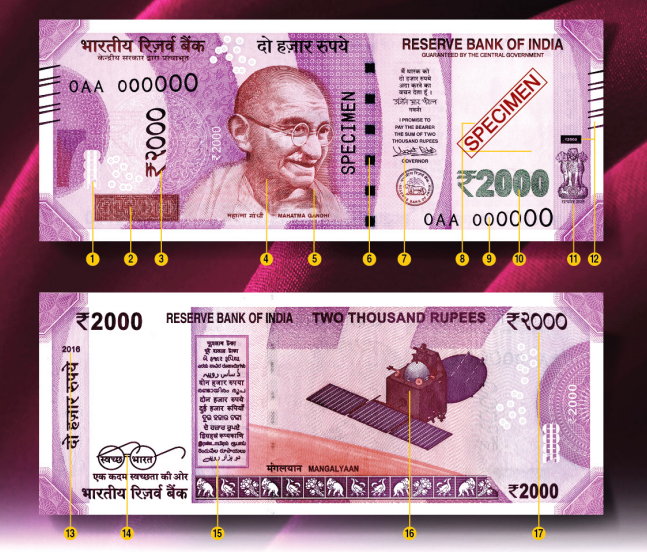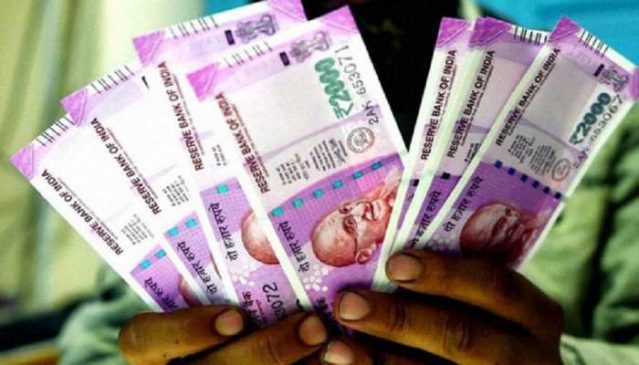Fake currency refers to counterfeit money or currency notes that is produced illegally and is used to deceive people or defraud the economy.
The Reserve Bank of India on Friday announced withdrawal of Rs 2,000 currency notes from circulation but gave public time till September 30 to either deposit such notes in accounts or exchange them at banks. Unlike the November 2016 shock demonetisation when old Rs 500 and Rs 1,000 notes were invalidated overnight, the Rs 2,000 notes will continue to be a legal tender till September 30.
Reportedly, the RBI had stopped printing Rs 2,000 notes in 2018-19 and the notes were rarely in circulation.
Read More: Is the world ending this Sunday? Here’s why May 21 is observed as ‘End of World Day’
The Rs 2,000 denomination bank note was introduced in November 2016, primarily to meet the currency requirement of the economy in an expeditious manner after the withdrawal of legal tender status of all Rs 500 and Rs 1,000 bank notes in circulation at that time.
The RBI said it has also been observed that Rs 2,000 denomination note is not commonly used for transactions. Further, the stock of bank notes in other denominations continues to be adequate to meet the currency requirement of the public, it added.
2000 Note Deposit Limit
Deposit into bank accounts can be made in the usual manner, that is, without restrictions and subject to extant instructions and other applicable statutory provisions, it said.
Handling of existing stock and receipts
RBI has stated that all banks shall discontinue issue of Rs 2000 denomination banknotes. ATMs/Cash Recyclers may also be reconfigured accordingly.
Banks holding Currency Chests (CCs) shall ensure that no withdrawal of Rs 2000 denomination is allowed from the CCs. All balances held in the CCs shall be classified as unfit and kept ready for dispatch to respective RBI offices.
All banknotes in this denomination received by the banks shall be sorted immediately through Note Sorting Machines (NSMs) for accuracy and genuineness and deposited in the currency chests under the Linkage Scheme or kept ready for dispatch to the nearest Issue Office of RBI.
The instructions contained in RBI Master Direction dated April 03, 2023 on detection, reporting and monitoring of counterfeit notes shall be meticulously followed.
The steps to check the Rs 2000 notes are listed below with the image of the note for better understanding.
Read More: What will happen to unclaimed deposits in banks current and savings accounts from June 1?
Counterfeit Notes
Banknotes tendered over the counter shall be examined for authenticity through machines. Similarly, banknotes received directly at the back office / currency chest through bulk tenders shall also be examined through machines.
No credit to customer’s account is to be given for Counterfeit Notes, if any, detected in the tender received over the counter or at the back-office / currency chest.
In no case, the Counterfeit Notes shall be returned to the tenderer or destroyed by the bank branches. Failure of the banks to impound Counterfeit Notes detected at their end will be construed as wilful involvement of the bank concerned in circulating Counterfeit Notes and penalty will be imposed.
Impounding of Counterfeit Notes
Fake currency refers to counterfeit money or currency notes that is produced illegally and is used to deceive people or defraud the economy.
Notes determined as counterfeit shall be stamped as “COUNTERFEIT NOTE” and impounded in the prescribed format by the RBI. Each such impounded note shall be recorded under authentication, in a separate register.
The Reserve Bank of India had introduced new design banknotes in the denomination of Rs 2000 as part of Mahatma Gandhi(New) Series.
The denomination has the motif of the Mangalyaan on the reverse, depicting the country’s first venture in interplanetary space. The base colour of the note is magenta. The note has other designs, geometric patterns aligning with the overall colour scheme, both on the obverse and the reverse. The size of the new note is 66mm x 166mm.
Read More: Petrol, Diesel Prices On May 21: Check New Rates In Delhi, Mumbai And Other Cities

How to check Rs 2000 note?
1. See through register with denominational numeral 2000
2. Latent image with denominational numeral 2000
3. Denominational numeral २००० in Devanagari
4. Portrait of Mahatma Gandhi at the centre
5. Micro letters ‘भारत’ and ‘India’
6. Colour shift windowed security thread with inscriptions “भारत’ , ‘RBI’ and ‘2000’. Colour of the thread changes from green to blue when the note is tilted
7. Guarantee Clause, Governor’s signature with Promise Clause and RBI Emblem towards right of Mahatma Gandhi’s portrait
8. Mahatma Gandhi’s portrait and electrotype (2000) watermarks
9. Number panel with numerals in ascending font on the top left side and bottom right side
10. Denominational numeral with Rupee Symbol, (₹2000) in colour changing ink (green to blue) on bottom right
11. Ashoka Pillar emblem on the right
Some features for visually impaired;
12. Intaglio or raised printing of Mahatma Gandhi portrait (4), Ashoka pillar emblem (11), horizontal rectangle mark with ₹2000 on the right, seven angular bleed lines both on the left and right sides
13. Year of printing of the note on the left
14. Swachh Bharat logo with slogan
15. Language panel
16. Motif of Mangalyaan
17. Denominational numeral २००० in Devnagri
Moreover, to complete the exercise in a time-bound manner and to provide adequate time to the members of public, the RBI has asked all banks to provide deposit and/or exchange facility for Rs 2,000 bank notes until September 30.
Also, the facility for exchange of Rs 2,000 bank notes up to the limit of Rs 20,000 at a time shall also be provided at the 19 Regional Offices (ROs) of the RBI having Issue Departments from May 23.
As per the RBI, about 89 per cent of the Rs 2,000 denomination notes were issued prior to March 2017 and are at the end of their estimated life span of 4-5 years.
The total value of such bank notes in circulation has declined from Rs 6.73 lakh crore at its peak as on March 31, 2018 (37.3 per cent of notes in circulation) to Rs 3.62 lakh crore constituting only 10.8 per cent of notes in circulation as on March 31, 2023.
In January 2014, the RBI announced withdrawal from circulation of all bank notes issued prior to 2005.
(With agency inputs)





































